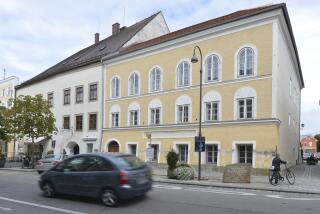Austrian Town Struggles to Cope With Its Links to a Young Hitler
- Share via
LEONDING, Austria — Word is spreading: Hitler lived here.
For decades, few people outside Leonding knew the Nazi dictator spent his boyhood in this picture-pretty town near the west Austrian city of Linz. In a country still struggling to own up to its past, Leonding would have preferred to keep its connection to Adolf Hitler out of the public eye.
But this year, the house where Hitler lived for six years until age 15 was becoming a safety hazard and a decision had to be made: to renovate it or tear it down? That, in turn, spawned a painful dispute.
Some in the town of 22,000 wanted the empty house designated as a memorial to infamy, while others demanded it be razed. Both ideas were too radical for Mayor Herbert Sperl, a self-described man of consensus.
Instead, he got the town council to approve a plan to renovate the house, leave it unidentified and use it to warehouse coffins for the nearby cemetery.
“Rededicating it for this function is one way of making sure Hitler isn’t being glorified,” he says.
Although renovation work already has begun, others remain opposed.
They point out that other buildings--Hitler’s birthplace in Braunau to the west and a school he attended in Fischlham to the south--display memorials or plaques condemning his crimes against humanity. And most Austrians today acknowledge that their country was not only a victim but a perpetrator during the Nazi era.
“I suggested that we should make it a monument, a memorial to the millions of Jews killed in the Holocaust,” says Dr. Claudia Mueller-Wechselberger, 42, a physician at the local hospital. “Turning the house into something it never was won’t change history.
“It’s time people here stopped turning away and started facing facts: Hitler lived here, among us.”
In March she wrote to the regional newspaper, the Oberosterreichische Nachrichten, complaining that the estimated $300,000 cost of renovation would be better spent turning the building into a memorial.
Reaction was quick--and in some cases scary. People accused her of casting their community in a negative light by publicizing its links to Hitler.
“I started getting anonymous calls, nasty cursing,” she says. “Some of them asked if I had children.”
A town councilwoman stopped greeting her. So did neighbors, and “one of them said that if I ever write another letter to the paper, I should make sure I don’t list my address again,” Wechselberger said.
Hitler was born in Braunau, on the German border, and lived there until age 3.
As Germany’s fuehrer, he paid triumphant visits to Braunau, Leonding and other boyhood haunts after Nazi Germany absorbed Austria in 1938.
Although Braunau’s “Hitler House” long been has used as a workshop for the mentally disabled, it remains a place of pilgrimage for admirers and a venue for anti-Nazi demonstrators.
Gerhard Skiba, mayor of the town of 16,000, says Braunau’s reputation as Hitler’s birthplace is an eternal burden all its residents must bear.
Lucas Dorn-Fussenegger, a member of the environmentalist Green Party, was one of only two of Leonding’s nine councilors who voted against the mayor’s plans.
His suggestion: Identify the house for what it was--Hitler’s home until 1904--and put up a mirror next to the sign “so that the visitor can see himself and recognize that the intolerance that led to the Holocaust begins with the little man.”
Opposed was the rightist Freedom Party of Joerg Haider, whose past praise of some Nazi-era policies and disparaging comments about Jews prompted the European Union to impose temporary sanctions on Austria when the party joined the government coalition two years ago.
Freedom Party Councilman Horst Wagenhofer says he would have preferred to “drag the house down rather than make it a magnet for leftist liberals and their graffiti.”
In any case, Hitler’s shadow is bound to go on looming over Leonding.
In the cemetery beside the house, his mother, Klara, lies in a grave by her husband, Alois, surrounded by burned-out stumps of votive candles that attest to frequent visitors.
Cemetery workers and passers-by shrug and profess their ignorance when asked who visits the graves. But at least one is not afraid to speak her mind.
“I’m glad someone is taking the time to treat their memory with respect,” said Ilse Maier, 55.
As for Hitler, she said, “It’s good that he lived here.”
More to Read
Sign up for Essential California
The most important California stories and recommendations in your inbox every morning.
You may occasionally receive promotional content from the Los Angeles Times.













